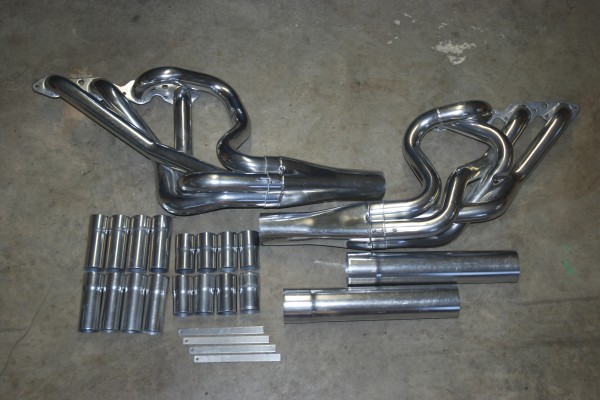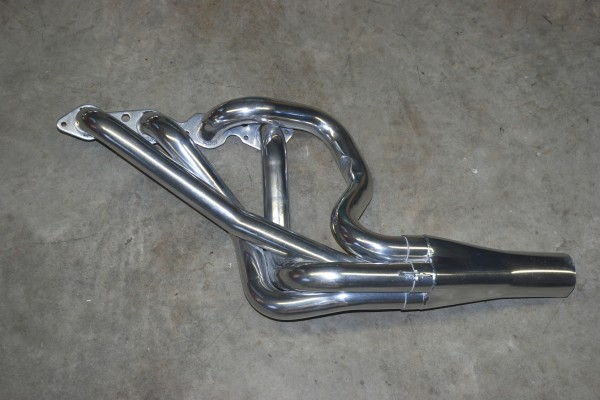We regularly field questions regarding headers.
Common header questions are centered around tube diameter, tube length, collector diameter, collector length, and so on. Some folks will tell you none of this matters. Others will tell you it all matters. We tend to agree with the latter, but when it comes to the racing world, one thing is pretty clear:
Experience and knowledge are absolutely paramount.
To answer to your questions, we went straight to two well-respected expert organizations in the biz—Hooker Headers and Reher-Morrison Racing Engines—for the lowdown on headers.
Exhaust Scavenging 101
Inside a header (with the engine running), “waves” of exhaust passing through the tubing are more or less manipulated to extract the burned gases from the combustion chamber. Simultaneously, those waves of exhaust help the intake side by pulling in a fresh air-fuel charge. If properly designed, the header set will provide a beneficial pressure balance between the intake and the exhaust.
An engine benefits from two different types of scavenging: Inertial scavenging and wave scavenging. Header design can have an effect upon both.
Inertial scavenging of gases begins as soon as the exhaust valve opens. Here, exhaust gases move past the valve and exit through the exhaust port into the header primary tube (and eventually working their way into the atmosphere). Hooker says the best power is produced with an exhaust gas speed of approximately 300 feet per second (as an example, if an engine has a 36-inch primary tube, it would take 1/100 of a second for the exhaust “pulse” to pass through the tube). Hooker notes that once the exhaust valve is closed, these gases still continue to move down the exhaust tube at a rate of 300 feet per second. But as it travels down the pipe, the exhaust cools and actually slows in speed. Behind this “pulse” is an area of low pressure that is expanding as the exhaust flows away. Once the last of this exhaust gas reaches the end of the primary tube, the area of low pressure has increased in size to include the full length of the tube for that particular cylinder.”
Wave scavenging does not involve the physical movement of exhaust gases up and down the header tubes. Instead, it deals with the sound waves created inside the engine. Hooker says that when an exhaust valve first opens, a pressure wave begins to travel—moving in excess of 18,500 inches per second (more than the speed of sound), which at sea level works out to 13,397 in./sec., depending on several factors). This sonic wave is moving quickly—much quicker than the ever-expanding exhaust wave we discussed above. When the sonic wave arrives at the end of the primary tube, a negative shock wave is generated, and this wave travels backward toward the exhaust port (because it is reflected).
What the header builder has to do is time the arrival of this negative pressure wave to occur just before the exhaust valve closes and while the intake valve is opening. If the negative wave arrives too soon or too late, the power potential of the next combustion chamber cycle is diluted.
If the engine has no collector (for example, a one-cylinder powerplant or an engine equipped with zoomies) the exhaust enters the atmosphere once it has left the primary tube. But in most headers, the exhaust enters a collector. If the low-pressure area we talked about above spills into another primary tube for a cylinder where the exhaust valve is just starting to open, that low-pressure area will help to pull exhaust gases from that cylinder. Here, the engine will gain an advantage, because there is less residual exhaust gas remaining in the combustion chamber (which can foul the incoming charge of fresh fuel and air).
By manipulating the diameter and length of a specific tube, a header builder can influence the size of that low-pressure front.
Header Diameter and Length
Reher-Morrison Racing Engines tells us there is a direct relationship between the diameter of the primary header tube and the exhaust velocity:
“The key when selecting a tube diameter is to find a happy medium between the free-flowing characteristics of large tubes and the superior scavenging of small, high-velocity tubes. Header tube diameters normally range from 1-3/4-inches to 1-7/8-inches for smaller, low performance engines up to big 2-3/8-inches tubes for large displacement, high-horsepower applications.”
Remember when we talked about how inertial scavenging helps to pull the exhaust from the combustion chamber? This also helps to draw in the air-fuel charge, with the end result being higher volumetric efficiency.
Hooker notes that by varying the length of the primary tube, you physically change the time it takes for the vacuum pulse (low-pressure area) to reach the header collector. Essentially that’s what “tuning” header tubes is all about. This tuning can help to complement the components you’ve selected for the entire car (camshaft, torque converter, transmission gear ratios, rear axle ratio, tire diameter, and so on). Header tuning can also have an effect on how the car works at a specific track.
As a rule of thumb, the need for a long primary tube is reduced as the speed of the engine increases, because there’s less time between cylinder firing, and the low-pressure area we talked about has less time to travel to the collector.
Getting the tube diameter and length right is extremely important. With all other factors being equal, the proper header tube size will allow you to obtain a superior scavenging effect with an increase in exhaust speed. Some folks will even tell you that the exhaust valve diameter determines the header tube diameter (not exactly correct). To a point, a header manufacturer can control the speed of the exhaust gas by changing the diameter of the primary tube. The smaller the diameter of the tube, the faster the exhaust will flow (keeping in mind the exhaust flow slows as it cools). A clever header builder will recognize that by varying both the length and the diameter of a given primary tube in a header, those tubes can be tuned to provide the largest amount of inertial scavenging.
As you can see, it can get complicated.
So where on earth do you start? Reher-Morrison offers excellent advice:
“At lower engine rpm, long tubes help maintain good exhaust scavenging and increase torque output. As engine speed increases, exhaust gas velocities increase and a shorter tube length tends to work better. The best you can do is find a header tube length that offers the best compromise between low and high end power. This is also why header length can be an effective aid in tuning the rpm range of a racing engine. Most racing engines will work best with (primary) tubes between 28 and 30 inches long. It is also very important that all header tubes are as close as possible to the same length. The tubes from the rear cylinders are closer to the collectors and need a few extra twists and bends to be as long as those (tubes) at the front of the engine.”
When it comes to cheap, universal “fits-all” headers with seriously mismatched tube lengths, Reher-Morrison points out these unequal tube lengths actual create a different tune for each cylinder. Hooker Headers adds there can be as much as a 50 horsepower difference between 5,500 and 6,500 rpm when compared to a set of pipes with more or less equal lengths. That’s why primary tube length is significant.
What about zoomies (the kind of headers you see on a supercharged funny car or dragster)? The truth is they will actually run pretty well in a couple of different power bands (for example, from 3,500 to 4,500 and then again from 7,000 to 7,500 rpm). But Hooker Headers tells us they can give up something like 25-35 horsepower or more between those two ranges.
We examine collectors and tuning in part two, click here to read the story.










[…] the first part of our Header Theory posts, we dug into the whys and how of header primary tube length. If you recall, Hooker Headers […]
Can you expand on this topic to cover stepped headers/systems? I’m trying to grasp how steps are spaced (by volume, by length, or by something else?).
It seems that stepped exhaust systems are akin to the general profile of a velocity stack (or a tuba – the musical instrument) to maximize flow.
[…] was the 3-part step header, which is a specific tool of NASCAR technology. A top-notch header can improve the energy the exhaust outputs as well as change how the car […]
[…] was the 3-part step header, which is a specific tool of NASCAR technology. A top-notch header may improve the energy the exhaust system outputs as well as alter how the car […]
Hi. I was talking to a friend of mine,he was telling me when he was at the US Nationals in 1969 he was looking at Bill Jenkins car. He said the 1st and 3D header tubes were larger than the 2d and 4th. When he asked Bill about the tubing diameters being different Bill simply said yes with a smile. Have you ever heard anything about this? Thank you for your time. Take care,Gary
Has anyone heard of running exhaust tudes 1 8 4 3 into one collector and 6 5 7 2 into the other with equal length tubes ?
Hello, I have a 1987 toyota pick up 22r engine. my rear exhaust pipe is 1.75 diameter . I do some in town driving but mostly freeway. looking mostly for fuel economy than power. what would be a good header size for this diameter and lengthwise. also is stainless a good choice for no rust and lasting. Thanks
The pressure wave actually travels at the speed of sound not faster then. The difference is that the speed of sound changes with temperature, it is travels faster in hot air- exhaust, then it does at room temperature.
The speed the pressure wave travels in the exhaust will actually vary depending on the egt which will vary on load, afr, ign timing ect.
what about the street rods old guys build with overdrive that never run over 3000 rpm or lower does collect length and tube size make a difference at this low rpm with a sbc? thanks Bill